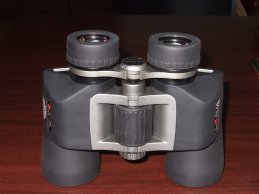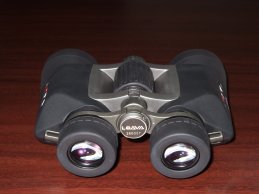

This 8x45 is another member of the LOAVA line, which is a popular brand name inside China. The same model is offered by Kunming's United-Optics as a member of their BW7 series. When compared to the 10x50 models which I have tested earlier, this 8x45 is rather compact and mobile. The binocular is sold along with a very robust case, made of hard plastic, which does efficiently absorb any mechanical impact during transport. The instrument is waterproof and the body is coated with a rubber skin to make the surface less sensitive to tough treatment during action. This is a classical travelers binocular and I had the opportunity to test it during a holiday trip through Xinjiang, the wild autonomous region in the North-West of China.
Fig. 1: The LOAVA 8x45
Coming first to a rather confusing part: Just as was the case with the 10x50, the technical specifications of this binocular are incorrect. I have measured an exit pupil of 5mm instead of 5.6mm as one would expect to find with an 8x45. This would imply an effective 8x40 and not 8x45 binocular. Additionally, the field of view is smaller than specified: The imprint on the binocular is reading 145m/1000m, or 8.3 degs true field of view, but my measurement delivered a value around 7.5 degs, somewhere between 130m and 135m per 1000m. It has been speculated that, perhaps, the magnification of this binocular might be closer to 9x than to 8x, which would explain the reduced exit pupil. I did the comparison with both the Docter 8x42 B/CF and the Nikon 8x30 EII, using one eye to look through the LOAVA and the other eye to look through the other binocular, to compare the sizes of objects in both images. For comparison, and to evaluate the accuracy of the method, I also used another binocular with 7x power. I found a clearly visible difference between the three 8x binoculars and the 7x, but no significant differences among the 8x glasses. I therefore imply that the LOAVA has in fact got 8x power and is effectively a 8x40 binocular.
The following table summarizes some of the specifications of the binocular.
| Real angle | Apparent angle | Eye relief | Exit pupil | Close focus | Weight | |
| of view (deg) | of view (deg) | (mm) | diam. (mm) | (m) | (gram) | |
| LOAVA 8x45 (a) | 7.5(b) | 60 | 19 | 5.0(c) | 3 | 890 |
The optical performance of this binocular is quite remarkable. Already on the first sight, the image appears very bright and with high contrast. I was informed that this model comes with a novel, further improved coating technology, and the tests seem to support that claim. During daytime, the image brightness is higher than that of my Docter 8x42 B/CF (which is the version made before 2007) and comparable to the Nikon 8x30 EII. The image is also very neutral without any color tint. In the night, ghost images of street lanterns are well suppressed, indicating that not only the lenses but also the prisms are treated with a high performance coating. Under the night sky, the star images remain point-like over about 80-85% of the field of view (radial from the center) - an excellent result! This binocular is therefore suitable for astronomy. This LOAVA is suffering a moderate amount of stray light, and a bright light source outside the field of view, or the bright sky after sunset can cause some diffuse light which is reducing the image contrast in certain situations. Overall stray light behavior of this LOAVA is superior to the Docter 8x42 B/CF, but inferior to the Nikon 8x30 EII.
The handling of this binocular is fine. Eye relief is sufficient for use with spectacles, and the twist up eye-cups help to optimize the distance to the ocular lens. I also found that these eye cups are fairly tight - this is an improvement over some earlier models, where the eye-cups had been too loose and were easily turned without intention. The oversized focusing wheel at the center of the hinge is very comfortably operated even with gloves. Whether the grease remains fluid at very low temperatures I have not tested. In the past, there have been complaints by amateur astronomers in Europe about focusers (of other binoculars made in China) becoming stiff under freezing temperatures. Kunming has partially responded by employing military grade lubricants with some of their models. The 8x45 has got one problem in common with the 10x50 version: When focusing, the ocular bridge sometimes becomes tilted, so that both oculars do not move simultaneously and do not maintain the same distance to the image plane. This is reducing the focusing accuracy and forces the user to turn the diopter setting in order to get both eyes back into focus. Here, Kunming should improve the precision of the mechanical engineering to assure a precise focusing.
In summary, this LOAVA is a rather compact and versatile binocular for traveling and hand held astro-applications. The optics is quite amazing, with excellent brightness and contrast and with a very good edge sharpness. Improvements are still possible in terms of stray light protection and with the focusing mechanism. Contrary to the official specifications, this is approximately an 8x40 binocular with 7.5 degs. field of view - Kunming must be more accurate here and provide precise specifications with their products. Optical engineering is all about precision and there is no space for fantasy numbers. Anyway I believe that this binocular offers a great performance for its price - that is why I have decided to keep it and I am actually using it whenever my favorite travel glass, the Nikon 8x30 EII, delivers too little light (with its 3.75mm exit pupil) or is running the risk of being drenched (it is not waterproof). In future, I would like to see an even more compact model of that line, perhaps a 7x35 or 8x32 on a similar quality level.
Holger Merlitz: merlitz@gmx.de
Last updated: Dec. 2008